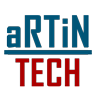When managing inventory in Artintech Software, adding new items is a fundamental task that ensures accurate tracking, seamless sales processes, and efficient stock management. Whether you’re introducing a new product, raw material, part, or finished good, or updating your catalog, correctly entering item details helps maintain data consistency and improves overall operational efficiency. This step-by-step guide will walk you through the process of adding a new item, from navigating the system to entering essential details, setting stock levels, uploading images, and finalizing the item for use in transactions.
Step 1: Navigate to the Items Module #
Why this step is important:
To add a new item, you need to access the correct module where all items are managed.
Best Practices:
- Ensure you have the necessary permissions to create new items.
- Familiarize yourself with the existing item list to avoid duplicates.

How to do it:
- Log in to Artintech Software.
- In the left-side menu, navigate to “General Setting” → “Items”.
- Click on the “New” button at the top-right corner.
Step 2: Enter Basic Item Information #
Why this step is important:
Each item requires essential details such as its name, SKU, and pricing for proper tracking.
Best Practices:
- Use a unique and descriptive name.
- Follow the company’s SKU numbering system for consistency.

How to do it:
- In the Item Name field, enter the name of the item (e.g., “ErgoComfort Basic Chair”).
- Fill in the SKU (Internal Item #) and Item Number.
- Enter the UPC (Barcode #) if available.
- Choose the Unit of Measurement (UoM) from the dropdown.
- Set the Selling Price and Estimated Purchase Price.
Step 3: Define Inventory and Stock Settings #
Why this step is important:
Proper stock management ensures smooth operations and prevents stockouts.
Best Practices:
- Set accurate minimum and maximum stock levels based on demand.
- Use reorder points to automate purchase recommendations.
How to do it:
- Enter the Minimum Stock Level (Safety Stock) and Maximum Stock Level.
- Set the Reorder Point to trigger restocking when inventory reaches a specific threshold.
Step 4: Provide Item Descriptions #
Why this step is important:
A well-written description helps customers and employees understand the product’s purpose and features.
Best Practices:
- Keep the descriptions clear and concise.
- Include product benefits and specifications.
How to do it:
- Fill in the Short Description (e.g., “Basic Ergonomic Chair”).
- Enter the Catalog Title Description (e.g., “Ergo Basic”).
- Write a Product Page Description with more details (e.g., “Basic office chair with lumbar support”).
Step 5: Set Tax and Sale Preferences #
Why this step is important:
This step ensures the item is correctly classified for taxation and sales.
Best Practices:
- Enable the correct checkboxes to indicate whether the item is taxable or saleable.
- If the item will be sold online, enable Ecommerce Saleable.
How to do it:
- Check the Taxable and Saleable options if applicable.
- Ensure Enabled is checked so the item can be used in transactions.
- Enable Ecommerce Saleable if the product will be sold online.
Step 6: Upload Item Images #
Why this step is important:
Images enhance product visibility and help users recognize the item quickly.
Best Practices:
- Use high-quality images.
- Ensure the images follow the supported format (PNG, JPEG, GIF, etc.).

How to do it:
- Click Browse under Item Main Image and upload the primary product image.
- Add up to 10 additional images under Item Alternative Images.
- Scroll to the bottom of the page.
- Click Save to store the new item in the system.
Congratulations! You have successfully added a new item in Artintech software. If needed, you can go back and edit any details later.




